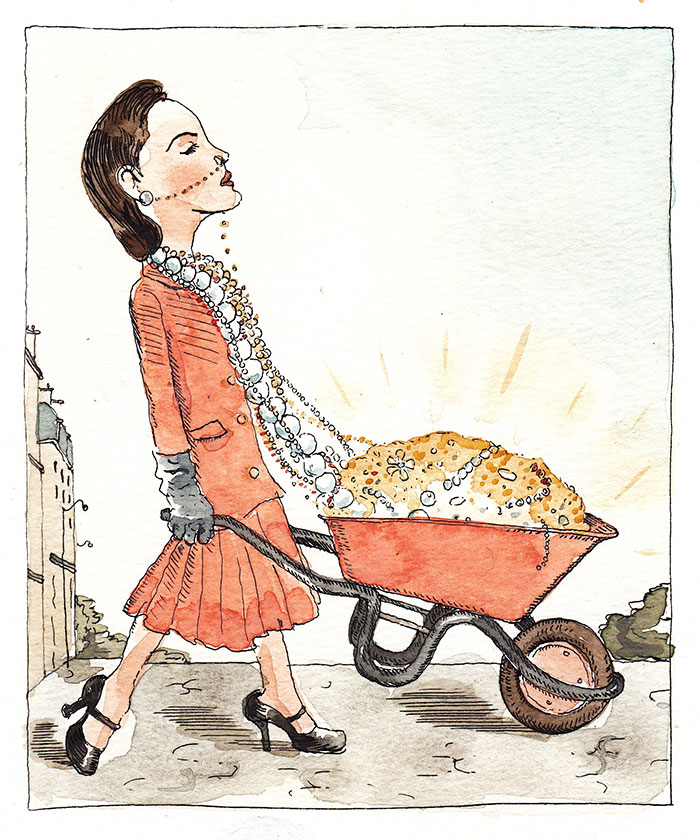Previous Article
Next Article
- AM WORLD
- 100 YEARS OF ASTON MARTIN
The Big Question
CHAIN REACTION
ARE THERE ANY LIMITS TO HOW MODERN JEWELLERY CAN BE WORN?
Words Stephen Bayley | Illustration Barry Blitt

At a cocktail party I once asked an actress about her tongue stud. She said with maximum cool: “It’s just another place to put jewellery,” a response that put me smartly in my place. Definitions of jewellery are changing because taste and technology are changing as well. If you want to test that troubled old trope about design being a bargain between form-and-function, you could do no better than analyse how, why and (precisely) where we pierce and enhance our bodies with ornaments.
And, of course, consider what we actually use for these ornamental piercings and enhancements. In 1927, Le Corbusier’s collaborator Charlotte Perriand produced a bracelet made of industrial ball-bearings. Today, ball-bearings have the period feel that pearls once had, while precious metals and rare minerals have long since given way to advanced polymers, carbon fibre and LEDs.
The ancient purpose of jewellery was twofold. It demonstrated wealth and status, thus had a symbolic function. But it was also portable, a real product benefit if you were by tribal inclination nomadic and, by circumstance, prone to rape and pillage. The status factor remains: the conference-goer’s laminated name-tag and lanyard is a form of jewellery. So too is the earpiece worn by security people. Increasingly colourful and ever more expressive headphones are jewellery. And when Apple introduced the first iPod Nano, designed to be worn on a lapel, data compression technology became jewellery too. Car designers speak of glittering lights as “jewellery”. I tell myself I have no taste for the stuff and then I look at all the watches I own and think again.
Indeed, only the dullest soul would still think modern conceptions of jewellery are restricted to rings, bracelets, necklaces and brooches. In 1967, the fashion-designer Paco Rabanne began making full-length “bodypieces”, blurring the distinction between fashion and art. But this art form walked and went to lunch. In the 1970s, David Watkins showed wearable sculpture. And Gerd Rothmann made an “Achilles’ Heel”, a beaten metallic covering for the foot’s posterior prominence. Impractical? Maybe, but who said that jewellery needed to be sensible?
New technologies empower designers to push definitions further. The furnace, forge, hammer and leather apron of tradition are replaced by stereo-lithography and 3D-printing. In a process known as additive manufacturing, the computer-controlled application of powderised or liquefied materials to a sculptural concept allows shapes of astonishing complexity to be created. And then worn.
Today there are no conceptual limits to what jewellery might be. The only limitations are the practical ones of what our bodies and cash reserves might support. Or, indeed, of finding new places to put it. Yet, no matter how freakish the new vectors, the essentials of jewellery are unchanged. Susan Cohn is a prominent Australian jeweller whose two-tone hair, colossal earrings and Titanic finger-rings suggest her taste for natty provocation. She says: “Jewellery can draw attention to our sexuality, enhance our beauty, show off wealth, signal status or project power.”
Quite so, but that would not have been news to any of the Iceni followers of Boudicca in her campaign against the Romans of AD61. They simply did not have access to layered composites.
Previous Article
Next Article
- AM WORLD
- 100 YEARS OF ASTON MARTIN
